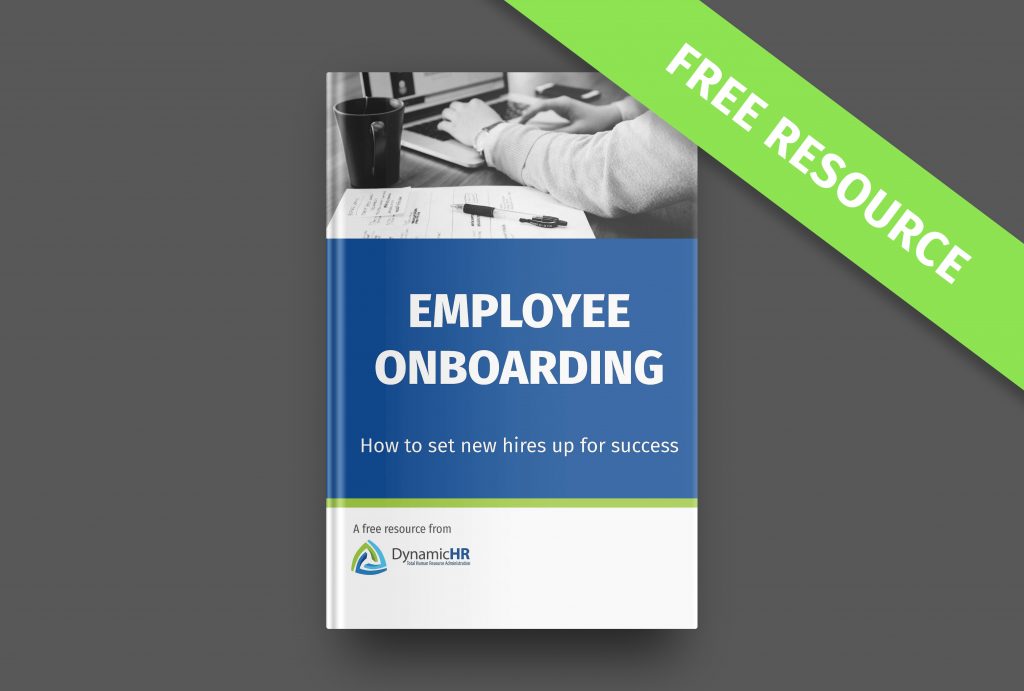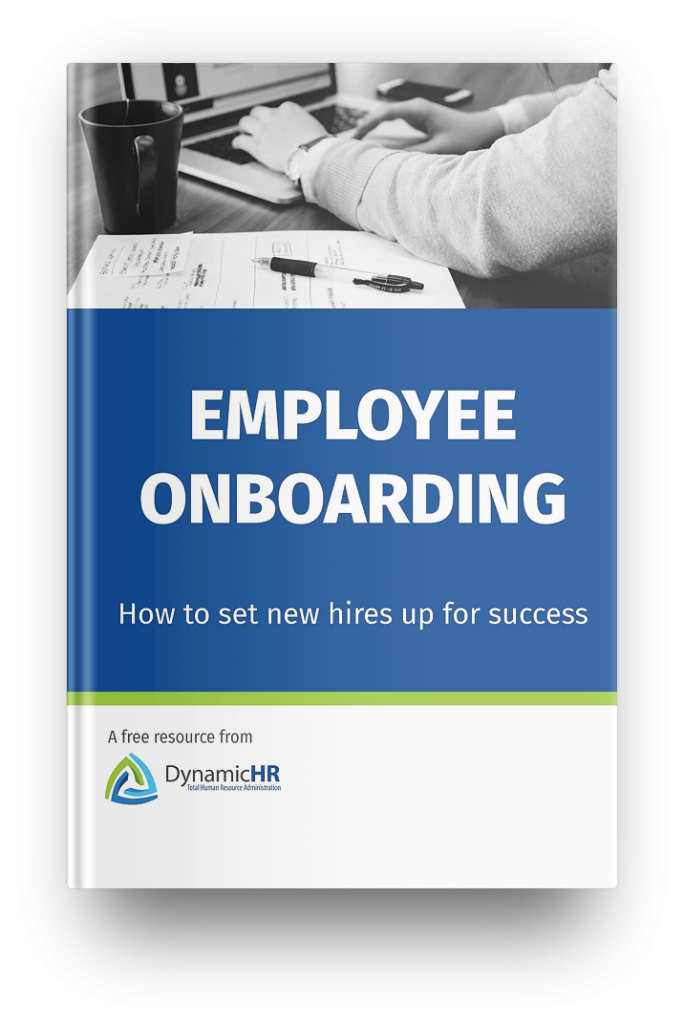If your onboarding process involves little more than paperwork, you’re missing out on a crucial opportunity to ramp up your new employees faster and lay a solid foundation for their long-lasting success on your team. Thorough onboarding can help you retain talent better.
A 2017 Career Builder survey reports that 36% of employers lack a structured onboarding process. The survey also highlights numerous negative impacts of having a weak or nonexistent employee onboarding program. Those drawbacks include lower productivity, higher employee turnover, lower morale and lower employee engagement – all of which drains your bottom line.
The costs of hiring and training employees are substantial, even if that employee stays for a short time. If they leave, you lose your entire investment. Employee onboarding sets your new hires (and your business) up for success.
The primary goal of your onboarding process is to create long-term, successful employees. There’s important steps to take to increase the likelihood that your new hire will stick around. Consider what’s in it for them. An onboarding process that gives them a thorough understanding of their role will empower them, and let them put their full effort into excelling. As a result, your company gets a strong performer who’ll be more likely to stay satisfied and engaged. You’ll also get more of an organizational commitment from them for the long haul.
When onboarding is done right, it can mean lower stress for that employee and everyone who works around them. The more people are clear on their roles and what they can bring to those roles, the more harmony in the workplace.
Employee onboarding is ongoing
A strong onboarding experience can improve the new employee’s satisfaction and long-term commitment level. Your overall recruiting strategy should take them all the way through hiring, and get them acclimated and up to speed on the nuances of your business and their role. If you skimp on any of these key steps, they’ll likely get lost and check out early in their tenure.
The onboarding process should span the new employee’s first three months, and can even start before the employee’s first day. That’s why it’s important to develop a comprehensive plan for this process, and what’s expected at each stage.
Onboarding starts before they start
Whether your new hire is changing jobs, a new graduate in the professional world, or even someone who’s transitioning from another life role, accepting a new job is both stressful and exciting. In many cases, a new hire may not start their job for a few weeks. That’s a lot of time to wonder if they made a good decision. Meanwhile, all their friends and family are probably congratulating them and asking about their new job and their new company. People tend to get nervous when there’s an absence of information. Try to dispel any anxiety or “buyer’s remorse” that could kick in after accepting a job offer. It’s important to keep in frequent contact – just as you were during the recruiting process. Keep that same pace going. For example, you may want to send a small amount of paperwork in the first few days, followed by a welcome video from the company or future team members a few days later. You don’t have to make contact every day, but consider staying in touch every few days until they actually start.
First impressions count
For a new hire’s first several days on the job, it’s important to keep the initial focus on interpersonal interaction. By sending paperwork to complete in advance of their start day, you get to make the onboarding process more digestible and personable. When you get the bulk of the paperwork out of the way beforehand, new folks don’t have to sit and fill out forms for hours on end. No one wants to do that on their first day – and that’s probably not the best use of their time anyway. You want those “first impression” moments to largely be time spent interacting with their new colleagues – not left alone to read the employee manual or watch training videos. Of course, compliance training and reading the employee manual are necessary boxes to check off early in their employment. But give some thought to how and when this information is presented to them, so it doesn’t consume their first day.
When you give new employees time to discover what they like about the people they’ll be working with, and the company they’ll be working for, they’re able to form a more meaningful connection with their role and your company. Welcome new hires with a warm, personal greeting, and have their workstation ready to go. Ensure that computers, phones, and other tools are fully set up before they arrive. Scrambling for missing items while your new hire is standing around sends the wrong message and wastes everyone’s time.
Start driving productivity and setting goals
Don’t let a lack of training or poorly defined roles result in your new hire sending the wrong email to the wrong person. Cover essentials such as email etiquette, communication expectations, how to answer the phone, response time for requests and returning missed calls.Making sure employees know proper procedures and protocols early in their first week helps protect your company’s image and streamline workflow among your teams. The first week is also an ideal time to have an initial conversation about their goals. Ask them to talk about their goals and give them specific goals to strive for. If you can, introduce them to the people and resources at your company who can help them reach those goals. By discussing short- and long-term goals, you give both the new employee and manager a gauge for how things are progressing. These conversations also allow your new employee to visualize their future with your company.
Appoint guides
A mentor or guide can help ramp up a new hire’s productivity and help them better interact with their coworkers. You may need multiple guides for a new hire, depending on their job description. If they have options, make sure the new hire knows who to go to for help, and that the mentors can maintain their productivity. If the mentors you assign don’t have the time to take on these responsibilities your new hires may get frustrated.
Also, don’t take any knowledge for granted. What seems routine and ordinary to you and your employees may be foreign to new team members. Some industries and companies practically have their own language. Don’t just expect your new team members to know the lingo right off the bat – help them get up to speed. It might be helpful to cheat sheet of acronyms and buzzwords that are commonly used around your office. Mentors can explain this document, and share anecdotes of how they first learned the terms.
Get new employee feedback
Make sure new hires know they’re free to share their ideas. Encourage problem-solving and innovation. They may not be comfortable doing so the first day, but keep asking as time goes by. They’ll likely have feedback and insights that can help them dig even deeper into their jobs and may even improve your employee onboarding process going forward. It’s important to do a formal feedback session with new hires after approximately 90 days on the job.
Questions to ask new hires:
- Is there something you thought you would know today that you don’t know at this point?
- Do you feel comfortable with the knowledge that you have and the work you’re assigned today, this week, etc.?
- Do you know where to go for help?
- Do you know where to locate resources required to do your job consistently?
- Do you have any feedback on our onboarding process?
- What part of the onboarding process was most helpful to you in getting you up to speed in your role?
- What do you wish you’d known in your first week?

If you’re just getting your onboarding program up and running, you should circle back around to other newer employees who started before you developed better onboarding. Ask them similar questions. Collecting this feedback is important because it prevents your onboarding from stagnating, and ensures the changes you’re making are effective. Revisit the process with each new hire, so you can keep improving the results.
The rewards of proper onboarding
Giving new employees a solid foundation through onboarding pays off for both the employee and your company. A well-planned, consistent onboarding program can greatly increase an employee’s performance, job satisfaction, and long-term commitment to your company. The business as a whole benefits from reduced turnover and improved morale. Along with these positives comes increased productivity. From the very beginning, you’re encouraging employees to keep their eyes on their performance goals, and potentially set even higher goals going forward.
Essential elements of employee onboarding
Although your company’s onboarding strategy should be uniquely tailored to your organization, let’s recap some of the key components to keep in mind:
Start the onboarding process as soon as the job is accepted. Take care of paperwork and stay in frequent contact before new hires come in for their first day.
Create an onboarding plan for each employee. It should cover specific steps for a new hire’s first week and span their first three months. Develop a plan and keep track of steps tailored to specific roles.
Give your new hire a warm welcome. Send a letter from the CEO or a video from their new team. If you can, take them to lunch. Whatever you do, make a great first impression.
Connect them with their new coworkers. Make sure others in the office take time to say hello and ask if they need help. This can prevent your new hire from feeling like a fish out of water.
Have their workspace ready for them on the first day. Their desk, computer and basic supplies should be ready to go when they arrive. You want new hires to feel like you planned to welcome them into your office and that their contribution is important – right from the start.
Give your new hire “role clarity.” Show them how their job contributes to the team and the overall success of the company. Instruct them on when and how to go up the chain of command. Start talking about goals, and set a date to discuss goals in detail with them.
Don’t rush their productivity. Before you assign them various projects and responsibilities, give new hires time to get a thorough understanding of their job, your company and the way you do business.
Introduce them to stakeholders. Once your new hire has started getting acquainted with their job and work environment, take them to meet supervisors and department heads. Let those stakeholders explain their own roles and what their department or division does.
Help them get comfortable in their new work environment. Share your company culture. Explain the unique aspects of your organization, and give them opportunities to observe them in action. Discuss the ways various people and departments interact and rely on each other
Don’t take shortcuts. Train them properly to help propel their productivity later. If you don’t, you’re setting them up for failure. By spending a sufficient amount of time now to train them the right way, you won’t waste time later fixing preventable mistakes.
Download the Free Onboarding Guide
Start developing an onboarding process that helps you retain talent and grow your core team
A PEO can help
The costs of improper employee onboarding are staggering, but sticking to solid practices pays off in a big way. It does take discipline to create a thorough plan and see it through. When you put in the effort, though, you’ll develop engaged employees who are committed to your company’s success.
If you’re feeling daunted about creating an employee onboarding program for your company or department, a professional employer organization (PEO) like DynamicHR can help you develop a detailed plan that creates better outcomes for new hires.





